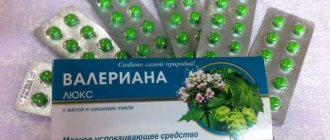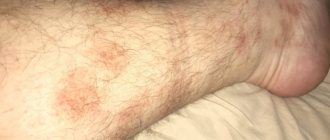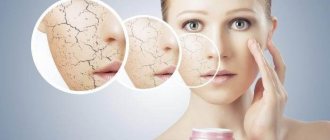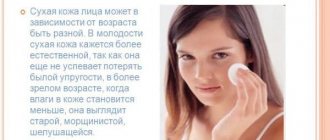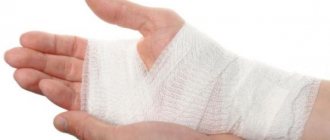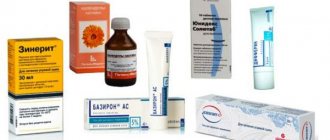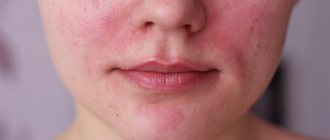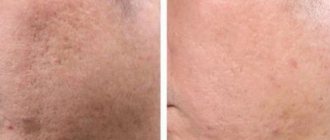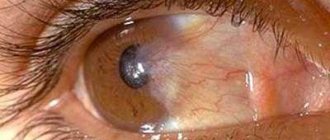Small bumps on the face - what are they?
The etymology of acne is clear to everyone: poor diet, stress, hormonal changes - all these factors can cause acne. What if it’s not the usual acne that appears on your face, but bumps? They can appear not only in those places where acne most often ripen (on the forehead, on the nose and on the chin), but also in those areas where almost no one gets acne. These are the corners of the lips, the area around the eyes. So what could it be?
Wen
A small subcutaneous tubercle on the face may turn out to be a wen. In medical terminology, such a tumor is called a lipoma. This is a benign formation that does not cause any discomfort to a person, except aesthetic. Lipoma can appear on both the face and body. You can't squeeze it out. This is not only useless, because... in the same place, the neoplasm will soon arise again, but it is also dangerous. You can learn how to get rid of wen from this article.
Wen often occurs in the area around the eyes
Milia
Milia is a small subcutaneous cyst. Popularly, such neoplasms are called millet grass. Often such tubercles are located in groups. There is also no point in squeezing them out.
To remove milia, doctors use a dermabrasion procedure, which involves deep grinding of the upper layer of the epidermis. If the cyst is small and located just under the skin, specialists can remove it with a lancet after steaming the skin. The procedure is quite painful, but quite tolerable. At the site of the removed milia, redness persists for some time, similar to what remains after mechanical facial cleansing by a cosmetologist. But after a couple of days the wound heals and becomes invisible.
Milia in a newborn
Hyperplasia of the sebaceous glands
If the skin is very oily, a phenomenon such as enlarged sebaceous glands may occur. At the same time, the skin becomes lumpy and thickened, but does not become inflamed, as with the development of acne. Upon closer examination, you can see a hole in the center of such a tubercle.
Another feature that makes it possible to distinguish hyperplasia of the sebaceous glands from wen and milia is that such tubercles are not hard to the touch, but rather soft. Their color is practically no different from the general skin tone, while milia and wen are white. Such subcutaneous bumps are eliminated with liquid nitrogen or cauterization with electric current.
Hyperplasia of the sebaceous glands
Subcutaneous comedones
Often, not inflamed purulent pimples appear on the face, but small bumps, white or the color of the skin. In this case, either just one such comedon or a whole rash in the form of tubercles can appear on the face. Subcutaneous comedones can be located not only in the traditionally oily T-zone, but also on the cheeks, cheekbones, and temples.
They are clogged sebaceous plugs formed due to insufficiently thorough cleansing of the skin and irregular exfoliation of its stratum corneum. Subcutaneous comedones can exist for a long time without becoming inflamed or enlarging, but they often transform into suppurating red pimples. To get rid of them, use scrubs regularly and cleanse your face daily with gel or foam. Professional cleaning in a cosmetologist’s office will also bring good results.
Subcutaneous comedones
Infection with subcutaneous demodex mite
Often, a bumpy rash on the face is a consequence of infection with a subcutaneous mite called demodex. This parasite lives in or near hair follicles. To make sure that subcutaneous pimples are the result of its activity, you need to have a skin scraping analyzed.
Red, bumpy rash on the face due to infection with demodex mites
Molluscum contagiosum
If white pimples appear on the face (they can also be flesh-colored), which do not cause pain upon palpation, this may be a symptom of infection with molluscum contagiosum. This disease is infectious in nature, meaning it can infect loved ones. Keep this in mind.
You can catch the molluscum contagiosum virus through sexual intercourse or by sharing common household items with an infected person: a comb, towels, dishes. Infection often occurs in kindergartens, because children use shared toys, as well as in public saunas and baths. The tubercles are quite voluminous in appearance and noticeably protrude above the surface of the skin.
This is what the rash looks like when an infection with molluscum contagiosum is diagnosed
Manifestation of allergies
For facial care we use the largest number of cosmetics: creams, gels, foams, lotions. The appearance of pimples may indicate that the product you are using is not suitable for you. The body's reaction is very individual, so even a luxury cream can help one person, but cause a rash in another. Many also have an intolerance to organic cosmetics that are popular today.
Sometimes bumps appear due to the use of inappropriate cosmetics. It’s difficult to call it an allergy in the literal sense; rather, it’s just intolerance
Types of skin irregularities and causes of their appearance
You need to know the enemy by sight. Therefore, first learn about various skin diseases that are accompanied by structural disturbances, deformation of the surface layer of the dermis and the formation of bumpy facial skin.
- Enlarged pores - ducts of sweat and sebaceous glands emerge through small points on the skin (pores). When there is excess production, the pores stretch, become inflamed at the edges, and rolls of dense tissue form.
- Acne and its consequences - It has been proven that the main cause of acne is hormonal imbalance. The body has an increased sensitivity to the sex hormone testosterone and responds by increasing the production of fat by the sebaceous glands. As a result, the ducts of the glands become clogged, and a dense, enlarging formation appears in this place. If an infection gets into the ducts, rapid infection occurs and an inflammatory process develops with ulcers and dense bumps on the surface. Demodicosis leads to such consequences. This disease is caused by tiny mites that penetrate enlarged pores or sebaceous glands.
- Scars and cicatrices - occur as a result of cuts, injuries, burns of the face, and prolonged inflammatory processes. In places of scars, the skin loses its collagen, elastic tissues are replaced by dense fibrous inserts. They deform the surface and disrupt all functions of the epidermis.
- Hyperpigmentation - ultraviolet rays in high doses cause sunburn of tissue. As a result, not only rough spots appear, but also the production of your own hyaluronic acid, and, consequently, collagen synthesis stops. All skin restoration processes are disrupted.
- Inflammation - any inflammatory processes require gentle treatment. “It will go away on its own” means that the process may result in the appearance of scars and unwanted deformities.
How to get rid of subcutaneous tubercles?
Treatment methods depend on the reason for the appearance of pimples on the skin and what they are. Often, with such a problem, it is recommended to check the condition of the gallbladder, thyroid gland, stomach and intestines. Most likely, in order to identify the cause, you will need to take a lot of tests: blood for hormones, cholesterol levels and other indicators, urine, feces, in some cases (for example, if you suspect demodicosis) - do a skin scraping analysis.
The reasons can be different: from staphylococcus infection to banal improper skin care, so it is better not to self-medicate. If you act on the wrong cause, there will be no result. As treatment, the doctor may prescribe the use of hormonal drugs, antibiotics, sedatives, and the use of local therapy agents, for example, Baziron, Skinoren, Zerkalin, Zenerit, Differin, etc. In addition, the dermatologist may suggest that you remove the subcutaneous tubercles using one of the following methods:
- electrocoagulation;
- laser treatment;
- ozone therapy;
- professional cosmetological facial cleansing;
- superficial skin peeling;
- mechanical removal with special medical instruments.
Wen, milia or pimple - no matter what type of neoplasm appears on the face, you cannot squeeze it out
The main rule of treatment is do not try to open the “subcutaneous tissue” yourself. This will only make the problem worse. The infection can spread to healthy skin, and an unsightly scar will remain in place of the squeezed out bumps. In addition, as a rule, the subcutaneous tubercles do not suppurate, and there is practically no content inside them, so there is, in fact, nothing to squeeze out there.
How a cosmetologist can help with “orange peel”
Does the skin on your face look like an orange peel? The situation can be corrected by contacting the salon. You will be offered the following procedures:
- Professional peelings will remove the surface layer of dead cells, which will have a beneficial effect on the texture of the skin. The procedure will also get rid of wrinkles and folds in the corners of the eyes.
- Microdermabrasion (facial resurfacing) is more effective because it provides deep cleansing. After the procedure, the effect of creams and serums will become more pronounced, because dead cells will not prevent the penetration of active substances.
- Cryotherapy involves exposure to cold, which reduces sebum production and tightens pores.
- Darsonvalization, carried out using ultraviolet light, removes dead cells, improves the color of the skin and eliminates acne. The procedure is often supplemented with the application of preparations with hyaluronic acid, which restores elasticity to the skin.
- Microneedling therapy is performed with the Dermapen device. He makes tiny punctures, for the healing of which the body increases the production of collagen. The skin becomes more elastic, the top layer is renewed, and the pores are narrowed.
To consolidate the effect, the procedures are repeated every 4-6 weeks.
If a cosmetologist offers mechanical cleaning to narrow pores, then his methods are hopelessly outdated. The option will please you with its budget, but the result will not be up to par.
Prevention methods
To make your skin delight you with its smoothness and even complexion, try to follow the following recommendations:
- If your skin is prone to uneven skin, pay special attention to the cleansing step. Use exfoliating gommages and scrubs. But on the contrary, you should avoid alcohol-containing lotions. They dry out the epidermis, causing the sebaceous glands to produce sebum in double volume. This only causes clogged pores.
- Review your diet. If you eat sweets and cakes every day, often have processed dinners and often drink alcoholic beverages, your skin is unlikely to look perfect. Include more greens, vegetables and fruits in your diet, and take a course of multivitamins.
- If possible, avoid bright makeup. Often, subcutaneous comedones are a reaction to the constant use of foundation. Also, the appearance of bumps can be caused by the use of cream eye shadow. Give preference to dry, crumbly options, and instead of foundation, apply mineral powder. It is much more suitable for problem skin.
It is better to use non-comedogenic products for skin care
Reviews from those who encountered the same problem
Ksenia, 23 years old: I got a lot of subcutaneous comedones after traveling to India. After the trip, I went to a cosmetologist, did a deep cleansing of my face, and the bumps no longer appeared. I think the reason was dirt and lack of care at that time.
Nadezhda, 32 years old: one day small bumps also appeared on the forehead and temples. They didn’t become inflamed, didn’t fester, and weren’t even particularly noticeable to others. I saw them especially clearly in sunlight, and also felt uneven skin when I washed my face. I couldn't get rid of them for two years. It turned out that the cause was problems with the gallbladder and stomach. After completing the course of treatment, the problem disappeared.
In men, subcutaneous bumps often appear on the cheekbones and neck. This is a manifestation of skin irritation after shaving
Svetlana, 21 years old: I think that cleanings from a cosmetologist in this regard give only a temporary effect. Over time, the “subcutaneous” come back again. To cure them completely, you need to take care of your health. When I went to a therapist with this problem, they sent me to examine the condition of my stomach, checked my intestines and hormonal levels. It turned out that the problems were in the stomach. I normalized my diet, now I practically don’t eat sweets, and my skin has become clear.
Our skin reflects all processes occurring in the body. Overeating, physical inactivity, chronic illnesses - all this does not affect her condition in the best way. The appearance of small subcutaneous tubercles can be either a symptom of an infectious disease or an intolerance to the cosmetic product you are using. To get rid of this problem, you must first find out what is causing it. This may require you to see a doctor. Well, following the principles of proper skin care and normalizing your diet will never be superfluous and will definitely help you achieve your goal.
